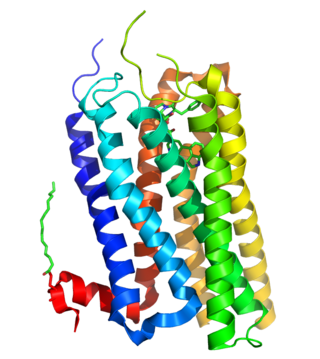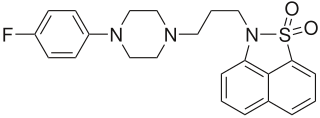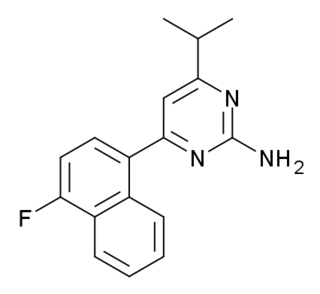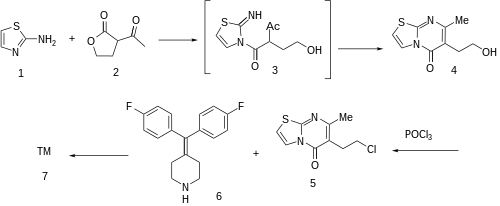
Mirtazapine, sold under the brand name Remeron amongst others, is an atypical tetracyclic antidepressant, and as such is used primarily to treat depression. Its effects may take up to four weeks, but can also manifest as early as one to two weeks. It is often used in cases of depression complicated by anxiety or insomnia. The effectiveness of mirtazapine is comparable to other commonly prescribed antidepressants. It is taken by mouth.

Ketanserin (INN, USAN, BAN) (brand name Sufrexal; former developmental code name R41468) is a drug used clinically as an antihypertensive agent and in scientific research to study the serotonergic system; specifically, the 5-HT2 receptor family. It was discovered at Janssen Pharmaceutica in 1980. It is not available in the United States.

Doxepin is a medication belonging to the tricyclic antidepressant (TCA) class of drugs used to treat major depressive disorder, anxiety disorders, chronic hives, and insomnia. For hives it is a less preferred alternative to antihistamines. It has a mild to moderate benefit for sleeping problems. It is used as a cream for itchiness due to atopic dermatitis or lichen simplex chronicus.

The 5-HT2A receptor is a subtype of the 5-HT2 receptor that belongs to the serotonin receptor family and is a G protein-coupled receptor (GPCR). The 5-HT2A receptor is a cell surface receptor, but has several intracellular locations. 5-HT is short for 5-hydroxy-tryptamine or serotonin. This is the main excitatory receptor subtype among the GPCRs for serotonin, although 5-HT2A may also have an inhibitory effect on certain areas such as the visual cortex and the orbitofrontal cortex. This receptor was first noted for its importance as a target of serotonergic psychedelic drugs such as LSD and psilocybin mushrooms. Later it came back to prominence because it was also found to be mediating, at least partly, the action of many antipsychotic drugs, especially the atypical ones.

5-Hydroxytryptamine receptor 2B (5-HT2B) also known as serotonin receptor 2B is a protein that in humans is encoded by the HTR2B gene. 5-HT2B is a member of the 5-HT2 receptor family that binds the neurotransmitter serotonin (5-hydroxytryptamine, 5-HT).

Setoperone is a compound that is a ligand to the 5-HT2A receptor. It can be radiolabeled with the radioisotope fluorine-18 and used as a radioligand with positron emission tomography (PET). Several research studies have used the radiolabeled setoperone in neuroimaging for the studying neuropsychiatric disorders, such as depression or schizophrenia.

Sarpogrelate is a drug which acts as an antagonist at the 5HT2A and 5-HT2B receptors. It blocks serotonin-induced platelet aggregation, and has applications in the treatment of many diseases including diabetes mellitus, Buerger's disease, Raynaud's disease, coronary artery disease, angina pectoris, and atherosclerosis.

Fananserin (RP-62203) is a drug which acts as a potent antagonist at both the 5HT2A receptor, and the Dopamine D4 receptor, but without blocking other dopamine receptors such as D2. It has sedative and antipsychotic effects, and has been researched for the treatment of schizophrenia, although efficacy was less than expected and results were disappointing.

Amperozide is an atypical antipsychotic of the diphenylbutylpiperazine class which acts as an antagonist at the 5-HT2A receptor. It does not block dopamine receptors as with most antipsychotic drugs, but does inhibit dopamine release, and alters the firing pattern of dopaminergic neurons. It was investigated for the treatment of schizophrenia in humans, but never adopted clinically. Its main use is instead in veterinary medicine, primarily in intensively farmed pigs, for decreasing aggression and stress and thereby increasing feeding and productivity.

RS-127445 is a drug which acts as a potent and selective antagonist at the serotonin 5-HT2B receptor, with around 1000x selectivity over the closely related 5-HT2A and 5-HT2C receptors. The role of the 5-HT2B receptor in the body is still poorly understood, and RS-127445 has been a useful tool in unravelling the function of the various systems in which this receptor is expressed.

SB-204741 is a drug which acts as a potent and selective antagonist at the serotonin 5-HT2B receptor, with around 135x selectivity over the closely related 5-HT2C receptor, and even higher over the 5-HT2A receptor and other targets. It is used in scientific research for investigating the functions of the 5-HT2B receptor.

AL-38022A is an indazole derivative drug which is one of a range of similar drugs developed for scientific research and with some possible clinical applications. It acts as a potent and selective agonist for the 5-HT2 family of serotonin receptors, with highest binding affinity for the 5-HT2C subtype and around 4x less affinity for 5-HT2A and 5-HT2B. In drug discrimination tests on animals, it fully substituted for both DOM and 5-MeO-DMT.

Volinanserin (INN) is a highly selective 5-HT2A receptor antagonist that is frequently used in scientific research to investigate the function of the 5-HT2A receptor. It was also tested in clinical trials as a potential antipsychotic, antidepressant, and treatment for insomnia but was never marketed.

ORG-37684 is a drug developed by Organon, which acts as a potent and selective agonist for the 5-HT2 receptor family, with highest affinity at 5-HT2C and lowest at 5-HT2B subtypes. It has anorectic effects in animal studies and has been researched as a potential weight loss drug for use in humans.

Pruvanserin is a selective 5-HT2A receptor antagonist which was under development by Eli Lilly and Company for the treatment of insomnia. It was in phase II clinical trials in 2008 but appears to have been discontinued as it is no longer in the company's development pipeline. In addition to its sleep-improving properties, pruvanserin has also been shown to have antidepressant, anxiolytic, and working memory-enhancing effects in animal studies.

Glemanserin (INN) is a drug which acts as a potent and selective 5-HT2A receptor antagonist. The first truly selective 5-HT2A ligand to be discovered, glemanserin resulted in the development of the widely used and even more potent and selective 5-HT2A receptor antagonist volinanserin (MDL-100,907), which is a fluorinated analogue. Though it was largely superseded in scientific research by volinanserin, glemanserin was investigated clinically for the treatment of generalized anxiety disorder. However, it was ultimately found to be ineffective and was not marketed.

25CN-NBOH is a compound indirectly derived from the phenethylamine series of hallucinogens, which was discovered in 2014 at the University of Copenhagen. This compound is notable as one of the most selective agonist ligands for the 5-HT2A receptor yet discovered, with a pKi of 8.88 at the human 5-HT2A receptor and with 100x selectivity for 5-HT2A over 5-HT2C, and 46x selectivity for 5-HT2A over 5-HT2B. A tritiated version of 25CN-NBOH has also been accessed and used for more detailed investigations of the binding to 5-HT2 receptors and autoradiography.

SB-243213 is a research chemical which acts as a selective inverse agonist for the 5HT2C receptor and has anxiolytic effects. It has better than 100x selectivity for 5-HT2C over all other receptor subtypes tested, and a longer duration of action compared to older 5-HT2C antagonist ligands.

Ocaperidone is a benzisoxazole antipsychotic. It was initially developed by Janssen, later licensed to French laboratory Neuro3D and then acquired in 2007 by German company Evotec. It was found to be more potent than risperidone in animal studies, but its testing was abandoned in 2010 after unfavorable results in human Phase II trials, as while it was effective at controlling symptoms of schizophrenia, ocaperidone produced an unacceptable amount of extrapyramidal side effects.

SB-200646 is a 5-HT2 receptor antagonist with anxiolytic properties in rats. It was the first 5-HT2 antagonist discovered to have selectivity of 5-HT2C/2B over 5-HT2A.





















